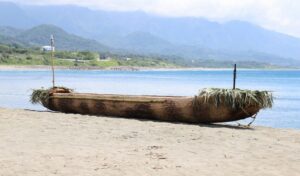Weird, bushy, top-heavy tree fossils found in a Canadian quarry come from an experimental period for Earth’s earliest forests.
Archaeologists Olivia King and Matthew Stimson first unearthed the strange trees in New Brunswick in 2017. Some of the fossils were immaculately preserved, thanks to an earthquake that buried lake-margin vegetation in the area. Remarkably, one of the five fossilized trees is completely intact. It is one of only a handful of entire plant fossils ever recorded.
Last week, Current Biology published a full study of the fossils. “The tree architecture consists of an unbranched, 16cm-diameter trunk with compound leaves arranged in spirals of ∼13 and compressed into ∼14cm of vertical trunk length,” the authors wrote.
Decoded, the trees look a little like enormous ferns, with thin trunks rising a little higher than a human. A huge toilet-brush of leaves spreads out from the top for five meters.

A computer-generated image showing the tree. Photo: Tim Stonesifer
“What it really does look like is one of those truffula trees from The Lorax,” King told CBC, referring to the famous children’s book by Dr. Seuss.
The 350-million-year-old trees existed before the dinosaurs and likely grew below the canopy, using their broad mop of leaves to make the most of the limited light. They are the earliest examples of trees growing beneath the canopy.
An experiment that didn’t catch on
The trees, named Sanfordiacaulis densifolia (after Laurie Sanford, the owner of the quarry), are so odd that lead author Robert Galstado likens them to an evolutionary experiment. Romer’s Gap is a period between 360 million and 345 million years ago where the fossil record for both animals and plants is similarly thin.
“The evolution of the plant kingdom underwent many different experimental forms that were successful for some million or more years of time, but didn’t survive the test of time,” Galstado told LiveScience.

Actual and reconstructed tree heights and ranges of Middle Devonian to Pennsylvanian trees. Photo: Matthew Stimson






